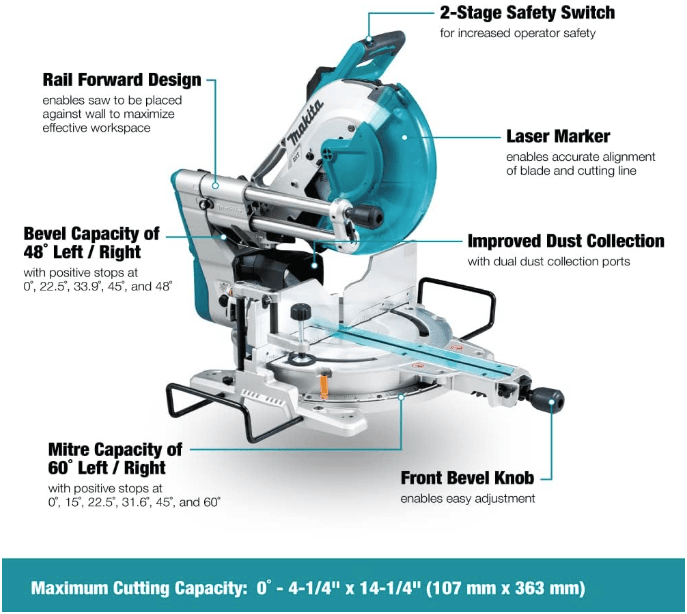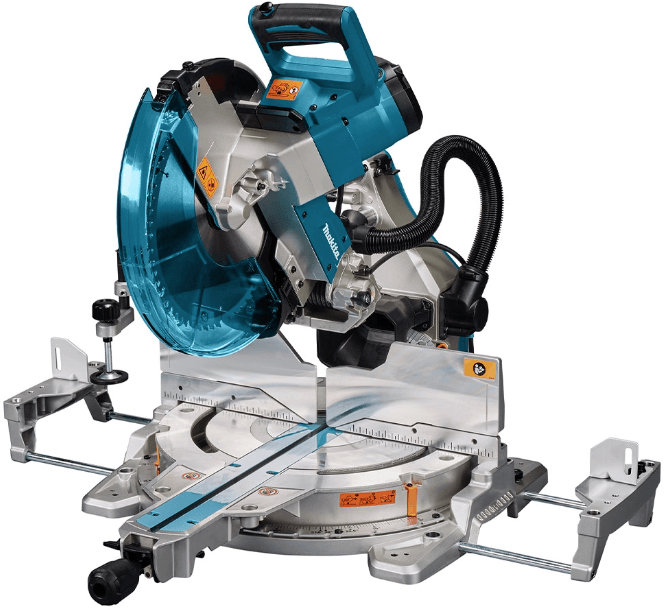There are so many Makita miter saw reviews on YouTube, it’s hard to figure out what I can add that would be new or different. But I can try!
Why I bought the Makita miter saw
My first miter saw was a 10″ Ryobi, the sliding compound model. It was a great saw for my needs as a part-time DIYer and worked fine for about five years. Over the next few years, it would occasionally fall out of square. I would readjust things to get it back to square and it worked for a little while, and then it would get out of alignment again.
And then for a few more years, I tried getting by without a miter saw. I did everything on my table saw or using a circular saw. It was an interesting experiment. The forced creativity probably made me a better woodworker, but it also showed me why I still needed a miter saw. There’s just no better tool for making fast and accurate cuts of longer stock on a repeated basis. So when I finally admitted it was time to invest in a new miter saw, I had two main criteria.
- It had to fit against the wall. I already knew where I wanted to put the miter station.
- After my experience with the Ryobi, I knew I was willing to pay a premium for a saw that would remain accurate for more than five years.
I did a lot of research on comparable models, but eventually landed on the Makita LS1219L.

The Good Stuff
- Accuracy. The blade was perfectly set at 90 degrees to the surface and the fence out of the box. I didn’t have to make any adjustments. As with most sliding miter saws, blade deflection (slight movement left and right) is possible at full extension, but it’s less than what I experienced on my previous miter saw. With proper technique, the saw is still accurate at full extension. I tested several of the built-in stops for angled cuts and found them to be accurate as well.
- Durability. I had been using the saw for about a year at the time of this review. That might not be long enough to speak to its long term durability, but it feels like a tank! It’s clear from the limited use of plastic and the weight (82 pounds) that it is designed to be your last miter saw.
- It’s smooth. I didn’t think it would be a big deal when I was doing the research, but the soft start feature is really nice. That and the heavy duty dual-rail system make for incredibly smooth operation. I know it’s not a fair comparison, but my Ryobi jerked at start up and its dual-rail system was very prone to getting clogged with sawdust.
- Dust collection. The dust collection on all miter saws is terrible, but it is less terrible on the Makita. It has two dust collection ports – a larger one near the cutting surface and a smaller one connected to the blade housing. I have them connected to a Craftsman Shop Vac and I’d estimate that it catches roughly 90% of the sawdust.
- Stock blade. Many miter saw brands keep the price down by skimping on the stock blade. As a result, many people immediately upgrade the blade, spending another $80-$120. But part of how this Makita miter saw justifies its higher price point is by including a high quality blade. In a year of working with several wood types and thicknesses, pvc pipes, and even T-track, the stock blade has performed well above expectations.
The Bad Stuff
- Bevel Adjustment. I don’t often make bevel cuts, but when I do I’m reminded how clunky it is on the Makita. Update – seven months later I still hadn’t used the bevel feature, so I decided to make a custom miter saw throat plate out of black walnut.
- Laser. The saw comes with a single laser that can be put on either side of the blade. It works fine, but at the price point I would have preferred either a shadow line that shows me exactly where the blade is going to land or two lasers that show me both sides of the blade.
Miter Saw Comparo
For a tool like the miter saw, some bonus content is in order. I don’t normally talk about the products I didn’t buy, but this was a big decision for me and I want to share more in case it helps some of you.
To set the stage, the most direct competitors to the Makita LS1219L at the time were the Delta Cruzer and Bosch GCM12SD. The Festool Kapex KS 120 is also a premium dual-bevel sliding compound miter saw, but it was never a serious consideration for me. It retails for $1700, more than double the Makita. Plus, I really think if you’re going to buy the Kapex, you should also buy the dust collection system that goes with it to get the full benefit of the Festool ecosystem. A mid-tier dust collector from Festool runs $679-$799. My little side hustle business cannot afford to migrate to Festool!
| Makita LS1219L | Delta Cruzer | Bosch GCM12SD | |
| Retail Cost | $799 | $649 | $649 |
| Sliding Mechanism | Dual Rods | Dual Folding Arms | Axial Glide |
| Max Vertical Cut | 8 inches | 6-1/2 inches | 6-1/2 inches |
| Max Horizontal Cut | 15 inches | 12 inches | 14 inches |
| Cut Line | Laser | Shadow | None |
| Soft Start | Yes | No | No |
| Bevel Range | 48 left / 48 right | 47 left / 47 right | 47 left / 47 right |
| Miter Range | 52 left / 60 right | 50 left / 60 right | 52 left / 60 right |
| Weight | 82 pounds | 57 pounds | 65 pounds |
| Warranty | 3 year limited | 5 year limited | 1 year limited |
Reviewing Performance
For me, the table shows that none of the saws stand clear on the basis of a feature set. It means the purchase needs to be based on performance or more subjective factors like aesthetics and brand preference. For performance, I turned to YouTube videos. Here are the three I found most useful for my purchasing decision.
- Makita and Bosch Review. Shout out to Justin Carroll for reviewing two of the three miter saws I was looking at! It sounds like he does a lot of trim and crown molding work, so his opinions might be biased toward that type of carpentry.
- Bosch and Ridgid Review. Since the Ridgid is exactly the same as the Delta, just different marketing, this review also covers two of the three miter saws I was looking at! He does a cool deflection test that shows how the Bosch is much better than the Ridgid/Delta at minimizing deflection. If only he had done the same test on the Makita!
- Makita Review. This review is by a woodshop teacher who replaced a Dewalt with the Makita. I like that he sees his students using the saw everyday and appreciates the durability of the Makita.
Conclusion
The Makita LS1219L 12″ Dual-Bevel Sliding Compound Miter Saw is a fantastic machine! Is it worth the premium relative to comparable saws from Delta or Bosch? I think it depends on your use-case. Most weekend woodworkers tackling DIY projects around the house will be perfectly happy with the Delta or Bosch. You can sometimes find better deals on the Delta, but the Bosch seems a little more accurate.
If those DIY projects turn into a side hustle where you are making stuff for paying customers, I think you can justify the premium for the Makita.
On a related note, the sweet spot for the Festool Kapex + Dust Collection is working in client’s homes. It’s lighter and more compact, making it much easier to tote around. The superior dust collection means you won’t leave a mess. Clients who know the Festool brand will appreciate your commitment to quality.
By the way, the link takes you to the product page on Amazon.com and if you subsequently buy it I will earn a small commission. Please know this does not change the price. If you go to the product page without using my link, you will see the same price. Here’s the official disclosure statement. As an Amazon Associate I earn from qualifying purchases. Thank you for supporting Moto Woodworks!
Finally, I only recommend products that I use on a regular basis and have proved their worthiness over time. Check out the Product Reviews page to see more.


